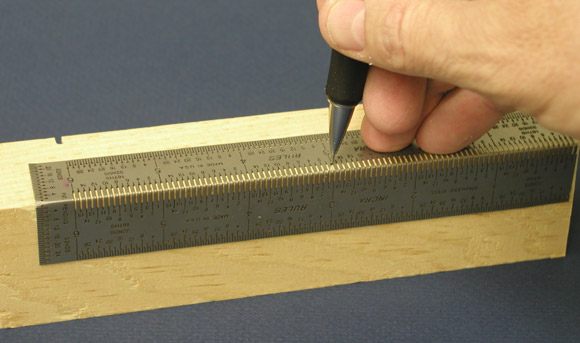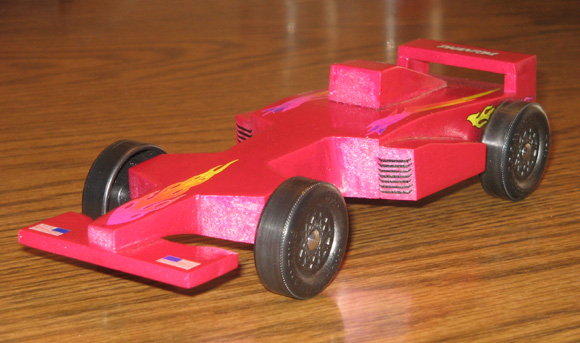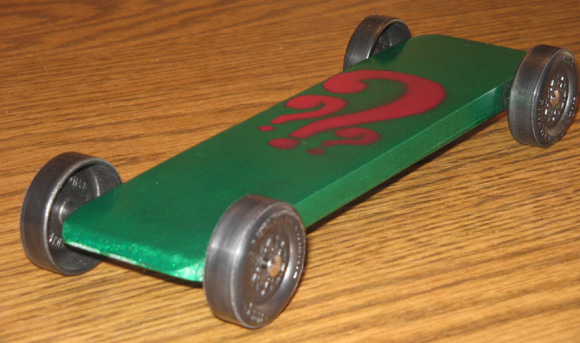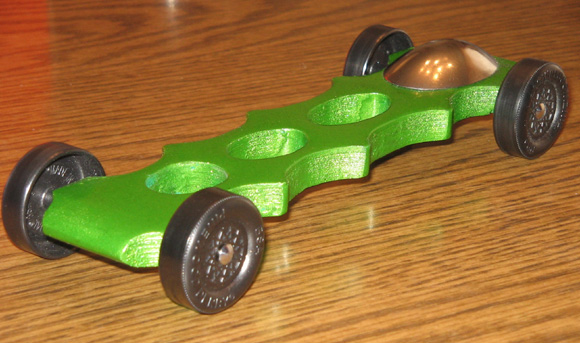– Shop Talk – Woodworking Tips
– Pinewood Derby Car Showcase
– Q&A
Shop Talk – Woodworking Tips for Pinewood Derby Car Building
By Randy Davis
When I was a boy, my father was involved in several home remodeling projects. At the time I was more interested in goofing off than learning carpentry, electrical wiring, plumbing, etc. I did learn the basics, but now as an adult, I wish that I had paid more attention so I could do more of my own work.
During the work sessions with my dad, he would pass along some tips to make the job go easier. The few I remember (and still strongly adhere to) are:
- Measure twice, and cut once.
- If you are going to buy a tool, spend the extra money to buy a good one. Good tools work better and last longer. Cheap tools just make the job harder.
- Don’t get ahead of yourself. Take it one step at a time.
These tips are certainly true for any woodworking project, and I try to apply them to home projects as well as pinewood derby car building. But of course, this is just the tip of the iceberg for useful woodworking tips. So, what I would like to share today are some woodworking tips that I have learned over the years that really help when applied to pinewood derby car building.
Measuring And Marking
- Use an accurate ruler and measure carefully.
- When marking drilling locations, make a slight indent at the drilling location with a sharp pencil.
- Use a square to draw lines perpendicular to the block (don’t eyeball it).
- Generally, lines for cutting are drawn so that they remain after the cut. They can then be sanded away.
Drilling/Pocketing

- Clamp the wood block in place. Don’t attempt to drill with one hand while holding the block with the other.
- Drill straight down with the drill no higher than chest level. If needed stand on a step stool to get the needed height.
- Use steady, even pressure on the drill. Pushing too hard can result in deeper holes than desired.
- For holes that do not go through the block, mark the drilling depth on the drill bit with a piece of masking tape.
- When drilling completely through the block, put a scrap piece of wood underneath the block. This will minimize chipping at the drill bit exit site.
Drill Press
- Use a vertical fence to set the offset from the bottom/edge of the block to the drilling location.
- Enter the wood slowly to minimize chipping.
- For deeper holes, drill part way through, retract the bit to clear the debris, then drill the rest of the hole.
Chiseling a Pocket
- Remove most of the wood with a drill.
- Clamp the wood block in place. Don’t attempt to chisel with one hand while holding the block with the other.
- Use a hammer and chisel together to make the first chisel cuts around the edge of the hole being chiseled.
- Tap the chisel gently, and remove a small amount of wood at a time. Taking too big of a bite can cause the wood block to split.
- Use the chisel by itself to remove any wood in the center of the hole.
- When removing a thin shaving, a hammer is not needed. Just push the chisel with steady pressure.
- Keep the chisel sharp to avoid splitting the wood, and most importantly, keep all body parts away from the cutting edge.
Sawing
- Make sure the wood block is clamped in place before cutting with a hand saw.
- When using a coping saw, make sure the blade is tensioned tightly.
- Start the cut by making short gentle strokes. When the saw is firmly in the wood, take longer, even strokes.
- Go slowly, and watch carefully to make sure the cut is staying along the cut line. If the cut is wandering, either back up and start again in the right direction, or start the cut from the opposite side.
- When cutting completely through a block of wood, place a scrap piece of wood tightly against the side of the block from which the saw blade will exit. This minimizes the amount of chipping at the saw exit point.
- To cut out a rectangle or square inside a car, drill a hole through the center of the area to be cut out, remove the blade from the coping saw, put the blade through the hole, reattach the blade and make the cuts.
Shaping
(aka Four-in-One Hand Rasp)
- Make sure the wood block is clamped in place before shaping with a wood rasp or rotary tool.
- A handy tool is a Shoe Rasp (aka Four-in-One Hand Rasp).
- Rasps only cut on the push stroke, so use most of your energy pushing, not pulling.
- To keep the rasp working properly, occasionally remove the sawdust from the rasp teeth. A “File Card” or a wire brush can be used for this job.
- Use a flat rasp to shape flat surfaces and outward-curved surfaces. Use rounded rasps to shape inward-curved surfaces.
Sanding
- Start with rough paper, and then progress to finer paper. A good progression is 60, 120, 220, and 400 grit.
- For sanding smooth, flat surfaces, use a sanding block. This is a tool made to hold a 1/4 sheet of sandpaper. Typically it has a soft surface, which is best for smoothing wood.
- Sand back and forth in the direction of the wood grain. On the end of the car, sand in a circular motion.
- To sand inside a body hole or a small surface, use a piece of sandpaper glued to a small flat object (Popsicle stick, small ruler, etc.).
- To sand inward curved surfaces, use a piece of sandpaper wrapped around a dowel rod (or a piece of broomstick).
Conclusion
Using the correct tools and using them properly will improve the look and the precision of your pinewood derby body. Just remember, “Measure twice, and cut once!”
Pinewood Derby Car Showcase
Today’s showcase cars are from Donald Welsh.
Pink Phantom
Here is the car that my daughter Laiken and I built for this year’s Awana Grand Prix. We found the Formula One design at Maximum Velocity; my daughter liked it because it was cool looking. I was not too surprised when she decided to paint it pink and add the colorful decals. The car ran really well in practice and raced really well in the derby to earn third place for speed in the TnT girls division. This was her first time racing in the derby and she was very surprised when they called her name at the end of the derby for her trophy.
Riddler
Here is the car that my son Luke and I built for this year’s Awana Grand Prix. The Riddler took second place for speed in the TnT boys division. The car is the extended version of the Maximum Velocity Wing design. Luke painted it green and I painted the questions marks on using a Styrofoam plate with the cutouts. We decided to make his car a three wheel runner, and after hours of sanding and polishing the axles and wheels it produced really good results.
Vaccinator
I built this Maximum Velocity Vaccinator design to race against my children during practice. The car is very quick. Everyone at the practice runs thought it was the coolest car they had seen and some were worried that it would be entered in the derby. After seeing this car on Maximum Velocity I couldn’t imagine it being any other color. The paint job is not perfect but it is a sweet car and my son said he wants to make one for next year’s derby.
Q&A
Have you ever done any comparison between your multi-groove speed axles vs. a single groove axle?
No, I have tested grooved vs non-grooved, but not single versus multi-groove. I believe the key factor is minimizing the amount of contact between the bore and the axle, not the number of grooves.
Note that both of our single groove axles (part 4052 and part 4098) have an oversized diameter. So either axle will outperform our multi- groove axle (part 4099) which has the standard BSA diameter.
Can your Aero Fenders be used on extended wheelbase cars? Which is better, pine or balsa?
The front Aero Fenders will not fit on an extended wheelbase car, however, the rear Aero Fenders will fit.
The balsa fenders are lighter, so they generally are preferred. However, the pine fenders are easier to implement.
Want Answers?
Do you have a pinewood derby-related question? If so, e-mail us your question.We answer all questions by e-mail, but not every question will appear in the Q&A section of the newsletter.
Back Issues
Are you a new subscriber, or have you missed some of the previous newsletters? Don’t miss out; all of the issues for Volume 5 through Volume 17 are posted on our web site.
Newsletter Contributions
We welcome your contributions. If you would like to contribute an article, a web site review, a speed tip, or a pinewood derby memory, please e-mail us.
Subscription Information
The Pinewood Derby Times is a free e-newsletter focused on pinewood derby racing. It is published biweekly from October through March.
If you haven’t already done so, please forward this issue to your pinewood derby friends. But please don’t subscribe your friends. Let them decide for themselves. Thanks.
If this newsletter was forwarded to you, why not subscribe to receive this newsletter. There is no cost, and your e-mail address is safe, as we never sell or share our distribution list.
To subscribe, send a blank e-mail to
[email protected]
You will receive a confirmation e-mail. Reply to the confirmation e-mail and you will start receiving the Pinewood Derby Times with the next issue.
Randy Davis, Editor, Pinewood Derby Times
E-Mail: [email protected]
(C)2018, Maximum Velocity, Inc. All rights reserved. Please do not reprint or place this newsletter on your web site without explicit permission. However, if you like this newsletter we grant permission, and encourage you to e-mail it to a friend.
Maximum Velocity disclaims any personal loss or liability caused by utilization of any information presented in this newsletter.
The Pinewood Derby Times is not specific to, and is not affiliated with the Boy Scouts of America, YMCA, Awana, or any other organization.
(R)Maximum Velocity is a registered trademark of Maximum Velocity, Inc.
(R)Pinewood Derby is a registered trademarks of the Boys Scouts of America.
(R)Awana is a registered trademark of Awana Clubs International.
All other names are trademarks of their respective owners.







